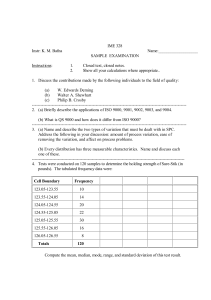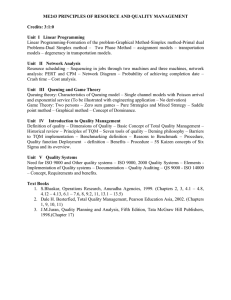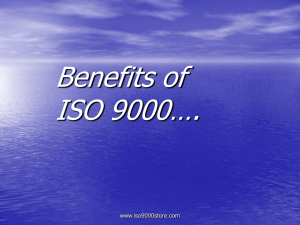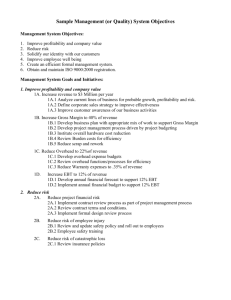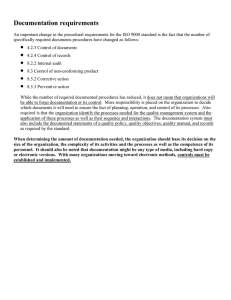North America survey finds significant decline in ISO 9000
advertisement
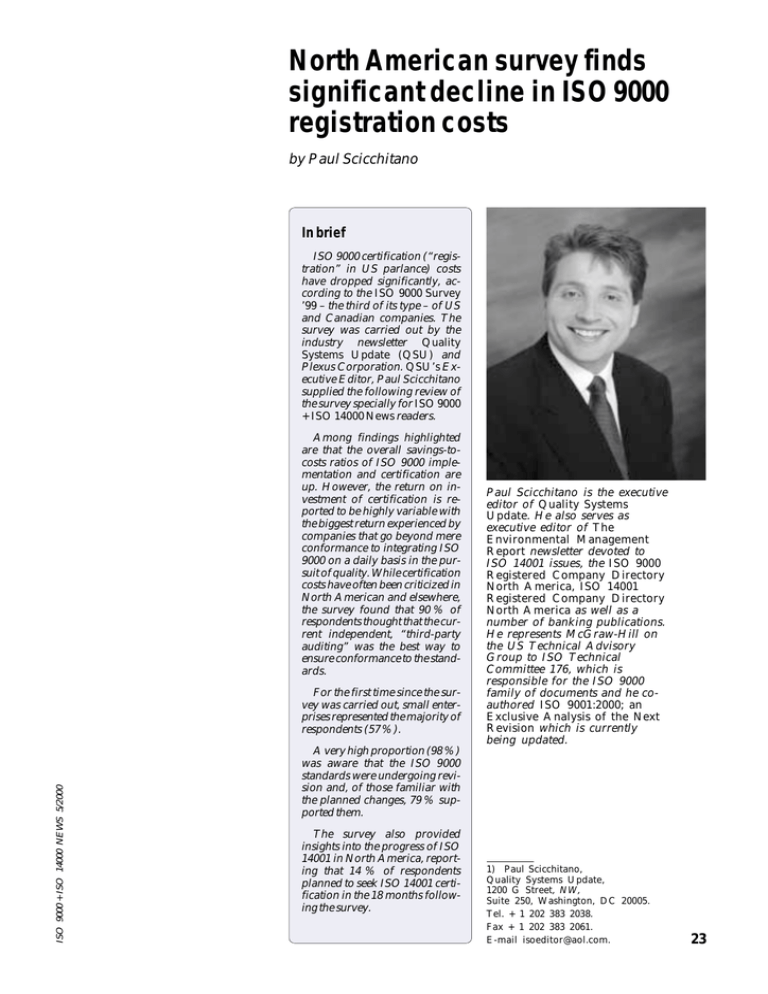
North American survey finds significant decline in ISO 9000 registration costs by Paul Scicchitano In brief ISO 9000 certification (“registration” in US parlance) costs have dropped significantly, according to the ISO 9000 Survey ’99 – the third of its type – of US and Canadian companies. The survey was carried out by the industry newsletter Quality Systems Update (QSU) and Plexus Corporation. QSU’s Executive Editor, Paul Scicchitano supplied the following review of the survey specially for ISO 9000 + ISO 14000 News readers. Among findings highlighted are that the overall savings-tocosts ratios of ISO 9000 implementation and certification are up. However, the return on investment of certification is reported to be highly variable with the biggest return experienced by companies that go beyond mere conformance to integrating ISO 9000 on a daily basis in the pursuit of quality. While certification costs have often been criticized in North American and elsewhere, the survey found that 90 % of respondents thought that the current independent, “third-party auditing” was the best way to ensure conformance to the standards. ISO 9000 + ISO 14000 NEWS 5/2000 For the first time since the survey was carried out, small enterprises represented the majority of respondents (57 %). Paul Scicchitano is the executive editor of Quality Systems Update. He also serves as executive editor of The Environmental Management Report newsletter devoted to ISO 14001 issues, the ISO 9000 Registered Company Directory North America, ISO 14001 Registered Company Directory North America as well as a number of banking publications. He represents McGraw-Hill on the US Technical Advisory Group to ISO Technical Committee 176, which is responsible for the ISO 9000 family of documents and he coauthored ISO 9001:2000; an Exclusive Analysis of the Next Revision which is currently being updated. A very high proportion (98 %) was aware that the ISO 9000 standards were undergoing revision and, of those familiar with the planned changes, 79 % supported them. The survey also provided insights into the progress of ISO 14001 in North America, reporting that 14 % of respondents planned to seek ISO 14001 certification in the 18 months following the survey. 1) Paul Scicchitano, Quality Systems Update, 1200 G Street, NW, Suite 250, Washington, DC 20005. Tel. + 1 202 383 2038. Fax + 1 202 383 2061. E-mail isoeditor@aol.com. 23 Conducted by industry newsletter Quality Systems Update and Plexus Corporation, the third major survey of North American certificate holders since 1993 also finds that about 14 % of US and Canadian respondents planned to seek ISO 14001 registration in the 18-month period following the survey published late last year. Total average costs associated with registration now stand at USD 156 000, down from USD187 000 in 1996 The effort drew responses from 1 150 respondents representing nearly 4 000 ISO 9000 certificate holders in time to be included in a 301-page analysis published by The McGraw-Hill Companies, Quality Systems Update’s parent organization in the United States. The newsletter was involved in all three surveys, partnering with Deloitte & Touche, then Dun and Bradstreet Information Services prior to Plexus. Total average costs associated with registration now stand at USD 156 000, down from USD 187 000 in 1996 at the time of the last survey, which only included US companies, and from USD 245 200 in 1993. With respect to ISO 14001 registration, 25 % of the respondents in the petrochemicals and plastics industries said they plan to seek registration, followed by 18,5 % of respondents from the food, tobacco, textile and wood products industries. Only 2,6 % of respondents said their companies were currently registered to ISO 14001. 24 Companies reported average total savings from ISO 9000 registration of USD 187 000, down slightly from USD 194 000 in 1996. But the overall savings-to-costs ratio is 1,2, which represents a significant improvement over the 1996 ratio, which was “barely positive,” and the 1993 ratio, which was negative, according to Alfred Marcus, who headed the survey team on behalf of Plexus and Quality Systems Update. Other team members were Dr. Eitan Naveh, post-doc Technion at the University of Minnesota, Gov Allen, a Ph.D. student at the university and Dr. Hyoung Koo Moon, visiting faculty there from Korea University. “The costs have gone down and the savings have gone down, but the costs have gone down much more rapidly than the savings so the overall savings-to-costs ratio is up,” explained Prof. Marcus, professor and chair of the Depart- ment of Strategic Management and Organization with the Carlson School of Management at the University of Minnesota. Return on investment “There is enormous diversity or variety in terms of the savings and in terms of the savings-to-costs ratio and return on investment that companies have realized,” he said. “I think the survey shows that For the first time, some 57 % of the respondents represented small companies companies that have customized it more, routinized it more, used it more for learning, for innovation and for going beyond the minimum have achieved more savings, a better savings-to-costs ratio and higher return on investment.” ISO 9000 Survey ’99 The complete survey results are published in ISO 9000 Survey ’99 (301 pages, including a fully searchable CD-ROM that performs customized reports based on company size, industry and registrar and other possible variables), which sells for USD 295. Contact McGraw-Hill customer service: Tel. 800 773 4607 (USA) Tel. + 1 614 759 3663 (foreign). or Plexus Corporation: Tel. 888-PLEXUS-1 (USA) Tel. + 1 651 644 4900. As was the case in the two previous surveys, the latest findings paint a statistically accurate portrait of the ISO management system phenomenon in North America by industry, sales volume and length of time companies have been registered. For the first time, some 57 % of the respondents represented small companies (those with annual sales of USD 25 million or less). In the last survey, only about a quarter of the respondents hailed from small companies, supporting a widely held theory that large companies adopted ISO 9000 first in North America and then passed it along to their suppliers. Alex Chong, president of Plexus Corporation, said the survey findings demonstrate that ISO 9000 goes well beyond traditional one-dimensional quality initiatives focusing on a single area of improvement such as defective parts per million. “ISO 9000 is not just for quality improvement,” he said. “It is seen as a management tool in looking at costs and being able to see that it leads to other benefits, other than just in reduction in defective parts per million; it is a system to run a business.” ISO 9000 + ISO 14000 NEWS 5/2000 The costs associated with ISO 9000 registration in the United States and Canada have declined significantly since 1993 while registered companies in the two North American countries report higher overall savings-to-costs ratios in the recently published ISO 9000 Survey ’99. Unlike the two previous surveys, the latest effort was conducted almost entirely via the Internet with management representatives from companies with one or more ISO 9000 certificates. In all, 33000 postcards inviting management representatives from the two countries to complete an on-line questionnaire were mailed on 16 August 1999. A second postcard and fax were sent later. In addition, a number of phone calls were also made as a follow-up. Annual sales 2.0 Total USD 0 – 25 (millions) < USD 25 – 200 (millions) > USD 200 (millions) 1.5 1.0 0.5 ISO 9000 is not just for quality improvement…it is a system to run a business 0.0 1993 Figure 2: Performance change and the extent to which this can be attributed to ISO 9000 Attributed to ISO 9000 Extent to which this change can be attributed to ISO 9000 Performance change since gaining ISO 9000 3.8 3.8 3 1999 Figure 1: ISO 9000 registration: savings-to-costs ratio Performance Improving 1996 3.7 3.7 3 2.7 3.7 3.6 3.5 High 3.4 2.9 2.7 2.5 2.5 2.2 Unchanged Medium Declining Low Customers’ Producsatisfactivity tion Defect rate On-time Sales delivery to customers Market share Cost of quality Export growth Figure 3: In the next 18 months, do you plan to pursue ISO 14001 registration? (in %) ISO 14001 ISO 9000 + ISO 14000 NEWS 5/2000 registration QS-9000 TE (supplement to QS-9000) registration registration TL 9000 registration AS9000/ AS9100 registration ISO/TS 16949 registration N = 170 N = 94 N = 21 N = 30 N = 24 N = 35 Total 13.8 % 7.7 % 1.7 % 2.4 % 2.0 % 2.8 % Agriculture, forestry & mining 15.0 % 6.0 % Services, trades & construction 13.0 % Food, tobacco, textile & wood products 18.5 % 3.0 % 1.5 % Petrochemicals & plastics 25.0 % 9.0 % 0.5 % 1.0 % 0.5 % 5.5 % Manufacturing metals & machinery 14.5 % 11.0 % 3.0 % 3.5 % 4.5 % Electronics & instruments 15.0 % 7.0 % 3.0 % 2.0 % 9.5 % 25 The findings suggest that experience with registration costs and savings varies widely depending on a number of variables, including whether companies attempt to exceed the basic requirements of ISO 9000, whether they use the system as a springboard for advanced quality practices, whether they incorporate audit findings into training and whether top management applies data to find solutions to problems. About 98 % of the respondents were aware that the ISO 9000 standards are undergoing revision be development of documentation, procedure creation and lack of management commitment. Highest gains Respondents reported their highest performance gains in the areas of customer satisfaction, defect rates, cost of quality, productivity and ontime delivery to customers “I think the important thing is the great variety in savings, savings-to-costs and return on investment that we saw and the extent to which more savings, higher savings-to-costs, and higher return on investments were correlated to making it a part of daily practice, using it as a springboard for the introduction of new practices, using it for the purposes of learning,” said Marcus. “Those results are very strong.” With respect to total costs, the standard deviation was USD 345 000, more than double the average. The standard deviation with respect to savings was even greater at USD 844 000, reflecting the disparate responses. “In short, you can lose a lot of money from ISO 9000 certification,” said Marcus. “You can gain a lot of money from ISO 9000 certification. It comes down to how you implement it.” 26 The greatest barriers to maintaining registration continue to Respondents reported their highest performance gains in the areas of customer satisfaction, defect rates, cost of quality, productivity and on-time delivery to customers. About 98 % of the respondents were aware that the ISO 9000 standards are undergoing revision, and of those familiar with the planned changes, close to 79 % supported them. About 90 % of respondents said they consider the external audit system in use today to be the best way to assure compliance to the standards. About 64 % of the respondents encourage all or some of the their suppliers to seek registration while another 21,5 % were considering such action. Only about 15 % said they do not encourage any of their suppliers to seek registration. ISO 14001 Based on a total of more than 40 000 ISO 9000 certificate holders in North America as reported by Quality Systems Update’s companion publication, the ISO 9000 Registered Company Directory North America, the findings could indicate there will be more than 5 600 new ISO 14001 registrations by May 2001. About 90 % of respondents said they consider the external audit system in use today to be the best way to assure compliance to the standards The last survey in 1996, prior to the publication of ISO 14001, found that about 31 % of US respondents intended to seek registration to the environmental management systems standard, but only about 8 % said they planned to be registered within two years of the time of that survey. There were then about 7 000 certificate holders in the United States. “There’s a doubling in the number of companies from the 1996 survey to this survey who say that they intend to become ISO 14001 certified,” observed Prof. Marcus. ISO 14001 was the most widely selected of the additional standards to which companies planned to register. Respondents were also given the choice of selecting QS-9000, the tooling and equipment supplement to QS-9000, TL 9000, AS9000/9100 and ISO/TS 16949. ISO 9000 + ISO 14000 NEWS 5/2000 Management representatives were given a special access code to complete the online questionnaire, and their responses were tabulated in November 1999 for an overall response rate of about 11 %.
